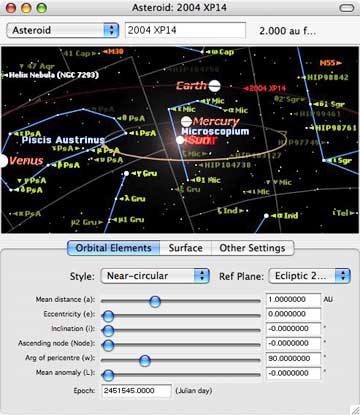
In our last issue, we alerted you to the impending close passage of near Earth asteroid 2004 XP14. Although many people tried to observe this object, I seem to be one of the few who actually succeeded. Here's how I managed it.
One essential for observing a faint fast moving body is to know exactly where it is going to be. The easiest way to do this is to use Starry NightŪ to plot its path. The problem with near Earth asteroids is finding accurate up-to-date orbital elements. Because near Earth asteroids pass close to the Earth, their trajectory across the sky is very slight until they are very close, because they are coming pretty well straight at us. This makes it very hard to define their orbit until they are nearly on top of us. Also, because they are small and passing close to large objects like the Moon and the Earth, their orbits are often perturbed at the last moment. The trick is to use the most recent elements calculated just a few hours prior to the pass.
The orbital elements in the Starry NightŪ data files are updated every 24 hours, and are good for almost every object. However, because this asteroid could change quickly, I wanted elements that were updated only a few hours before I went out to observe, so I decided to use elements from the IAU's Minor Planet Centre downloaded a few hours before the pass. All you need to do here is type in the asteroid's name, in this case "2004 XP14," tell it (down towards the bottom of the page) that you are using Starry NightŪ, and click the "Get ephemerides/HTML page" button. In Starry NightŪ, you choose "New Asteroid Orbiting Sun" from the File menu, and paste the values from the MPC web page into the boxes:

You should give the asteroid a name different from the one already in Starry NightŪ; otherwise Starry NightŪ will use its own elements to replace the ones you've entered. I printed out a series of charts at half hour intervals along the track.
I figured that the earliest I could observe the asteroid was at 01:30 am EDT (2006 July 02 05:30 UT) when it was just clear of the trees to my northeast. I set up my 11" Newtonian with a Nagler 22mm eyepiece, yielding a magnification of 63x and a field of view of 1.3 degrees. The transparency was poor, the Milky Way being just barely visible overhead. I aimed my telescope for the point where the asteroid was predicted to be at 01:30, and waited for it to cross my field of view. Nothing. I tried the same at 02:00, and again came up empty. I began to suspect that the MPC elements were off, so I switched back to the Starry NightŪ elements and tried again at 2:30. Again, nothing.
In a previous observation of a near Earth asteroid some years ago, I recalled that I'd almost missed it because the asteroid was way ahead of its predicted position, so I located the spot where 2004 XP14 would pass at 03:00, through a nice little bat-shaped asterism centered on 1 Persei. I was on target at 02:50. Almost immediately I noticed a tiny speck of light motoring along. I quickly glanced at my watch and saw the time was 02:53 (06:23 UT), no idea how many seconds past. The asteroid was a full eight minutes ahead of schedule! I looked back in the eyepiece and caught a second glimpse a bit further along the path, then lost track of it. It was much fainter than I had expected, no more than 10th magnitude judging by the stars around it, and moving very fast.
On rechecking the Starry NightŪ predictions, I saw that Starry NightŪ's prediction had the path right, but it showed the asteroid in the position I observed at a time of 03:01. I rechecked the predictions from the MPC elements and they were even worse: the track was shifted to the northeast and the position was off by eleven minutes! In the morning I located the elements I now know I should have used, on the JPL Horizons web site. These elements are a bit trickier to enter, because they use different terminology and abbreviations than Starry NightŪ does, but I figured them out by comparing the numbers with the ones in Starry NightŪ:
| JPL | Starry NightŪ |
| A | Mean distance (a) |
| EC | Eccentricity (e) |
| IN | Inclination (i) |
| OM | Ascending node (Node) |
| W | Arg of pericentre (w) |
| MA | Mean anomaly (L) |
| EPOCH | Epoch |
| H | Absolute magnitude (Other Settings) |
When I entered these elements into Starry NightŪ, both the track and the times were in very close agreement with what I observed.
Given the inaccuracy of the predictions I was using, it's a miracle I saw the thing at all. What saved the day was choosing a spot well ahead of the predicted position and then waiting in ambush for it to pass through. For the record, the asteroid was 444,424 km away when I spotted it, as compared to a distance of 405,624 km to the Moon.
Starry NightŪ is a great starting point to help you plan your observations. Since fast moving objects are unpredictable, it's always a good idea to download elements calculated just a few hours before the pass and input them into Starry NightŪ as a back-up plan.
August 2006
Geoff has been a life-long telescope addict, and is active in many areas of visual observation; he is a moderator of the Yahoo "Talking Telescopes" group.













